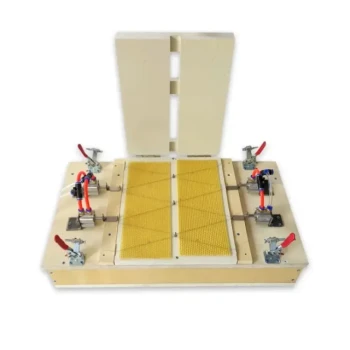On July 21, beekeepers observed mixed progress in their colonies after feeding them ½ gallon of 1:1 sucrose syrup. A spot check revealed that most colonies had started building out wax combs on the new foundation frames. However, a critical finding was the near-total absence of beebread, which signaled that the trial should be concluded.
The key takeaway is that while sugar syrup can stimulate wax production, it cannot sustain a colony's growth. The observed lack of beebread—the bees' essential protein source—was a definitive indicator that the colonies lacked the nutritional resources to raise new brood, making further stimulation with syrup ineffective.
Analyzing the Key Observations
The report from July 21 provides a snapshot of hive health by looking at three distinct factors: the feed provided, the bees' construction activity, and their nutritional stores. Understanding each piece is crucial.
The Stimulative Syrup Feeding
Beekeepers fed the colonies ½ gallon of 1:1 sucrose syrup. This ratio of sugar to water is known as "stimulative feeding."
Its purpose is to mimic a natural nectar flow, encouraging the queen to lay eggs and motivating the workers to build new wax comb.
Progress on the Comb Foundation
The observation that "most, but not all, colonies had drawn a few frames of foundation" indicates partial success. "Drawing foundation" means the bees are building their hexagonal wax cells onto the starter sheets provided by the beekeeper.
This activity shows the syrup was providing enough energy for wax production in many hives. However, the uneven progress across colonies is a common and important detail, suggesting variability in colony strength or health.
The Critical Lack of Beebread
The most significant finding was that "very little beebread was found in the combs." Beebread is a mixture of pollen and nectar that is fermented and stored as the bees' primary source of protein, vitamins, and fats.
Without adequate beebread, the colony cannot feed its larvae. It is the nutritional cornerstone for raising the next generation of bees. Its absence is a serious warning sign.
Why These Findings Matter
Observing these factors together allows a beekeeper to make an informed management decision. The combination of comb-building and a lack of protein creates a clear picture of a nutritional bottleneck.
The Signal to End the Trial
The purpose of a feeding trial is typically to encourage colony expansion. This requires two things: energy (from nectar or syrup) and protein (from pollen).
By July 21, the colonies had energy from syrup but no protein from beebread. Continuing to feed syrup would be pointless; the bees could not use the energy to raise new brood without the essential protein to feed them. This imbalance is why it was "time to end the trial."
A Sharp Contrast with Earlier Conditions
This situation marked a rapid decline from just two weeks prior. On July 7, the same colonies had an "adequate ring" of beebread around their brood nests.
The disappearance of these protein stores between July 7 and July 21 indicates that the natural pollen sources had dried up and the colonies had consumed their reserves. This highlights how quickly a hive's nutritional status can change.
Making the Right Choice for Your Hive
Interpreting these interconnected signs is fundamental to successful beekeeping. Your actions should always be based on a holistic assessment of the colony's needs.
- If your primary focus is rapid expansion: Ensure the bees have access to both carbohydrate (syrup) and protein (natural pollen or a pollen substitute patty).
- If your primary focus is honey production: Avoid stimulative feeding during a natural nectar flow, as bees may store the syrup instead of the nectar.
- If you observe low pollen stores: Immediately provide a high-quality pollen substitute to prevent a break in the brood-rearing cycle, which can severely weaken the colony.
Ultimately, effective beekeeping relies on observing the colony's signals and providing the right resources at the right time.
Summary Table:
| Observation | Significance |
|---|---|
| Syrup Feeding (1:1 sucrose) | Mimics nectar flow, stimulates wax production and egg-laying. |
| Wax Comb Drawn on Frames | Partial success; shows colonies had energy for construction. |
| Critical Lack of Beebread | Definite warning sign; colony lacks protein to raise new brood. |
| Conclusion: End the Trial | Further syrup feeding is ineffective without a protein source. |
Ensure your colonies have the right nutrition for healthy growth. The July 21 trial shows that success requires more than just sugar syrup. HONESTBEE supplies commercial apiaries and beekeeping equipment distributors with the high-quality feeding supplies and equipment needed to support both energy and protein needs. From pollen substitutes to essential hive tools, we help you make informed decisions for your hives.
Contact our expert team today to discuss your apiary's nutritional strategy and browse our wholesale catalog.
Related Products
- Professional Dual-End Stainless Steel Hive Tool for Beekeeping
- HONESTBEE Advanced Ergonomic Stainless Steel Hive Tool for Beekeeping
- Professional 3-Bar Frame Grip with Integrated Hive Tool
- Yellow Plastic Bucket Pail Perch for Beekeeping
- Beehive Handle and Frame Rest Cutting Machine: Your Specialized Hive Machine
People Also Ask
- What are some safety precautions and care tips for hive tools? Ensure Beekeeping Efficiency and Hive Health
- What are the features of a regular hive tool? The Essential Multi-Tool for Every Beekeeper
- What does the term 'nectar shake' or 'shaking nectar' indicate? A Key Sign of a Strong Nectar Flow
- What equipment and implements are needed by beekeepers besides the hives? Build Your Essential Beekeeping Toolkit
- Why is post-harvest equipment maintenance important? Protect Your Apiary's Health & Investment



















